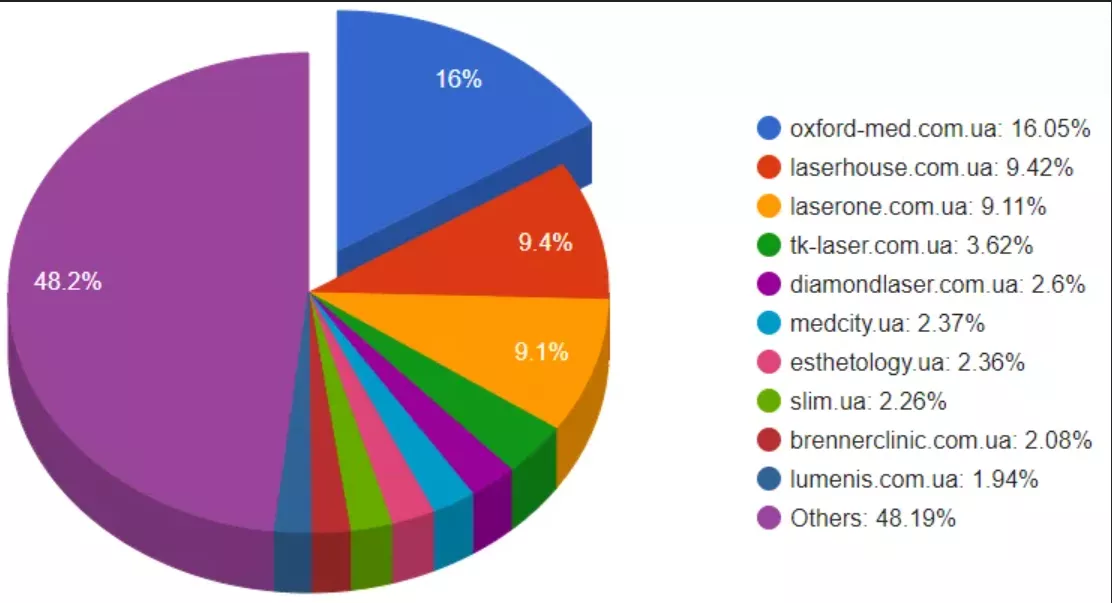How to Boost Your Organic Search Ranking by 44% for the Cosmetology Category: SEO Case Study for Oxford Medical
The Client
Oxford Medical is a network of medical clinics in Ukraine. With 38 branches across 22 cities, the clinic aims to provide high-quality medical care to as many Ukrainians as possible. Oxford Medical's modern medical centers are staffed by highly qualified physicians, equipped with new medical equipment, and offer a wide range of services.
The Challenge
Since we've been working with the client for a long time, we've already done a lot of basic SEO and even launched a blog.
After negotiating the key aspects of further promotion, we agreed to perform category-based website optimization and started with the Cosmetology category. We aimed to:
- Increase the number of subcategory pages on the site.
- Optimize the pages for users.
- Increase organic search rankings for the category.
Before optimization, the initial rate of organic search results for the Cosmetology category was 11.16%.
The Strategy
The main promotion strategy involved analyzing the top results and improving the content of the pages.
The Solution
To improve the search engine ranking of the category, we decided to work on three main areas:
- content
- internal linking
- link equity
- After analyzing the content of the client's competitors in the medical industry, we decided to improve and update the articles already published on the Oxford Medical blog. This was one of the most extensive tasks.
We also performed several standard SEO activities for the content, including:
- Keyword list creation.
- Manual meta title, description, and H1 tag creation.
- Analysis of the published content on the pages and making recommendations for improvement. For new pages, we created technical requirements for writing the text from scratch.
- Recommendations for adding certain items most commonly used by competitors on similar pages.
- Suggestions for adding some helpful blocks and sections to the page, such as details about the doctors performing the procedures, a block with prices, or an FAQ.
- We then performed internal linking. Again, we started with additional analysis using Serpstat, a search engine optimization platform, to look for keywords that had been added to the pages as link text (anchors).
In addition, we worked on improving the distribution of rankings among the pages to increase their visibility in the Google search engine. To do this, we created links from blog pages to priority categories. And vice versa: we created links from categories to blog pages and to new category pages.
- Since the project was quite large, it was important to properly allocate the link building budget between the pages. We looked for pages that would generate quick results if they were improved. Specifically, we took into account the keyword frequency, the types of anchors already placed, and the types of link texts on competitors' pages.
Overall, we increased the number of links in the Cosmetology category by 55%.
We had an interesting experience working on other category pages for Oxford Medical. After the update was released, one of the categories dropped, and we had to quickly allocate part of the budget and our time to it. We analyzed the situation and came up with recommendations to improve the category. The takeaway is that you need to monitor and react quickly to changes in the SERP because even a small loss of position in the top 10 results can significantly reduce the number of customers coming from search results.
The Results
As a result of our efforts, organic traffic in the Cosmetology category increased by 80% compared to 2021.
Furthermore, visibility in the category increased by 122%, from 11.32% in March to 25.14% at the end of June 2023.
We also increased market share from 11.16% to 16.05%, improving Oxford Medical’s organic search ranking by 44%.
Related Articles
ChatGPT-5: How It May Affect AI SEO
Uncover how ChatGPT 5 will flip your SEO strategy over and reveal the ways to boost your online presence using it.
Amazon Global Advertising Prep: Why Does Cultural Fit Matter?
Unveil the perks of global advertising on Amazon and tips on how you should adapt your marketing approach to the customers from different countries.
Automatic Analysis of Customer Data (RFM Analysis) Using Google BigQuery
This article discusses how RFM analysis helps businesses identify their most valuable users, optimize their resources, retain existing customers, and attract new ones





